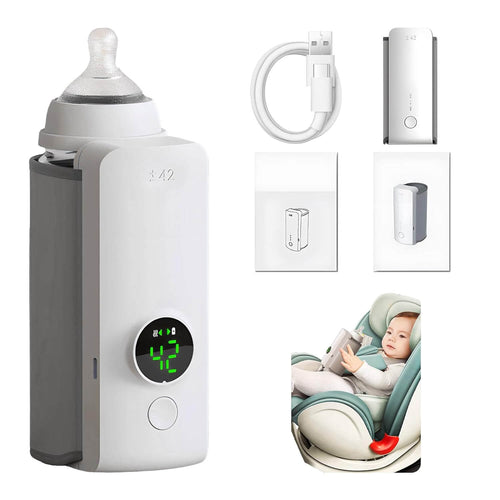
Overactive Letdown Breastfeeding: Cause, Symptom & Solution
If milk flows too quickly when you breastfeed, you’re definitely not alone. Overactive letdown can make both you and your baby uncomfortable—think choking, coughing, or lots of fussing during feeds.
When milk gets released with too much force, your baby might struggle to keep up, and the whole process can feel stressful. Recognizing and managing this fast milk flow is key to making breastfeeding more comfortable.
Silver nursing cups can help protect sore nipples between feeds. They give you relief from friction and irritation, and you don’t need extra creams or complicated care.
With the right strategies, you can make feeding smoother for both you and your baby. Let’s look at the signs, causes, and practical ways to handle overactive letdown. You’ll also find tips for everyday care and some helpful gear—like a portable bottle warmer for travel or an ergonomic baby carrier for hands-free comfort. For parent-focused tips beyond travel gear, explore UNICEF’s parenting resources for Overactive Letdown Breastfeeding support. For quick relief during Overactive Letdown Breastfeeding, explore our breastfeeding essentials curated for comfort and support.
Key Takeaways
- Fast milk flow can cause fussiness and feeding struggles.
- Simple steps and tools may help you manage letdown effects.
- Comfort and support matter for both you and your baby.
What Is Overactive Letdown in Breastfeeding?

Some parents notice discomfort, breast tenderness, or leaking milk through their clothes, especially if milk flow feels too fast. You might also feel irritation during feeding.
Understanding what causes this can help you feed your baby more comfortably. The let-down reflex, your hormones, and the difference between overactive letdown and oversupply are all worth knowing.
How the Milk Ejection Reflex Works
The milk ejection reflex, or let-down reflex, is how milk moves from your breast to your baby. When your baby suckles, tiny muscles squeeze milk out, usually within a minute or two of nursing.
Milk travels through small ducts and comes out at the nipple. This reflex is automatic and helps your baby get milk easily.
Sometimes, the reflex is just too strong. Milk can spurt out quickly, making your baby cough or pull away. That’s overactive letdown.
It’s a normal part of breastfeeding, but when it’s too forceful, it can get messy and uncomfortable.
The Role of Oxytocin and Prolactin
Oxytocin is the main hormone behind the milk ejection reflex. When your baby suckles, oxytocin tells the muscles around your milk glands to contract and push milk toward the nipple.
Prolactin helps by making more milk in the first place. It works alongside oxytocin, with levels rising during pregnancy and after birth to build your milk supply.
If oxytocin releases quickly or in large amounts, milk may come out too fast. This can overwhelm your baby and lead to overactive letdown.
Managing this hormone balance can make breastfeeding smoother. See an overview of let-down physiology at NCBI for evidence behind Overactive Letdown Breastfeeding.
Differences Between Overactive Letdown and Oversupply

Overactive letdown means your milk comes out in a fast, strong flow. Oversupply is when you make more milk than your baby needs. They’re related, but not the same.
Overactive Letdown:
- Milk shoots out quickly.
- Your baby may cough or choke during feeding.
- Feeds can get messy or feel rushed.
- Breasts might leak or feel swollen.
Oversupply:
- You make more milk than your baby needs overall.
- Your baby might gain weight well but spit up more often.
- Breasts can feel full or uncomfortable all the time.
- You might get plugged ducts or mastitis.
You can have one without the other. Some people with oversupply have a slow letdown, while others with normal supply have a forceful letdown.
Knowing the difference helps you and your care team find the best support. For more, check out overactive letdown and oversupply.
Signs and Symptoms of Overactive Letdown
When breast milk flows too fast or forcefully, both you and your baby can feel uncomfortable. You might notice milk leaking often or breasts that feel full and tender.
Babies may cough or pull away while feeding because the milk flow feels hard to handle. Spotting these signs early helps you make feeding more comfortable for both of you.
Common Symptoms in Babies

Babies with overactive letdown often cough, choke, or gag during the first few minutes of breastfeeding. They might pull off the breast or get fussy because the fast flow overwhelms them.
You might hear gulping sounds or notice your baby swallowing air, which can lead to gas and discomfort. Green, frothy stools are common if your baby gets too much foremilk.
Spit-up or signs of reflux may pop up. Babies might also pull off and re-latch repeatedly, showing frustration.
If your baby struggles to stay latched, it could slow milk removal and cause feeding issues later.
Signs Experienced by Breastfeeding Parents

You might notice milk leaking through your clothes between feeds. Breasts can feel heavy, full, or tender if milk moves quickly and pools unevenly.
Some parents feel a strong tingling or pulling when letdown happens. You might get clogged ducts or discomfort from engorgement if milk isn’t emptied regularly.
Nipples can get sore if your baby clamps down to slow the flow. You might see milk dripping on your baby’s cheeks or clothes during feeds.
How to Tell if You Have an Overactive Letdown
To figure out if you have overactive letdown, watch your baby feed in the first few minutes. Rapid gulping, coughing, or pulling away are strong clues.
Notice if your breasts leak milk without feeding or pumping, or if they feel swollen or painful. Green or frothy baby stools can be another sign.
If your baby spits up often or seems cranky while feeding, take note. A lactation consultant can help you assess latch and milk flow.
Managing milk flow with positioning and feeding techniques can make a real difference. For more, see overactive let-down.
Causes and Risk Factors
Breastfeeding with overactive letdown can cause nipple soreness, milk leaking, and baby gagging. Knowing why it happens helps you find better comfort and care.
Several things play a role, like your milk supply, breastfeeding habits, body changes, and how your baby latches.
Oversupply and Too Much Milk
One major cause is simply making too much milk—oversupply. When your body makes more milk than your baby needs, milk can come out too fast.
Genetics or natural variation in milk production often play a part. Pumping often or feeding on one side only can boost supply even more, making letdown faster.
You might notice heavy leaking, swelling, and a full feeling before feeding. An IBCLC (International Board Certified Lactation Consultant) can help you manage milk ejection and supply.
Breastfeeding and Pumping Patterns
Frequent or long pumping sessions can boost milk supply and sometimes cause overactive letdown. Pumping after every feed or using high suction tells your body to make more milk.
Timing matters, too. Pumping too often or too close to feeds can increase milk volume quickly, leading to fullness and fast flow.
A balanced feeding and pumping schedule—without overstimulating milk production—can help. An IBCLC can help you adjust pumping to match your baby’s needs.
Anatomy and Hormonal Influences
Your body’s anatomy and hormones also affect the milk ejection reflex. Some people have more sensitive nerves in their breasts, which can make milk release rapidly.
Hormones like oxytocin control milk letdown. Differences in oxytocin release can make milk flow stronger or faster.
Physical changes after birth, including shifts in hormones or tissue, may increase the chance of overactive letdown. Health professionals can help you sort out any anatomy or hormone issues.
Infant Latch and Nursing Challenges
How your baby latches can affect milk flow and comfort. A weak or shallow latch may make milk spray or flow too fast, causing your baby to cough or refuse the breast.
Babies who struggle with sucking or swallowing might find a fast flow hard to manage, leading to fussiness or breaks during feeding.
Improving latch position and nursing technique with support from a lactation consultant can help your baby handle milk flow better. A good latch can also reduce nipple soreness and feeding issues linked to overactive letdown.
Managing and Soothing Overactive Letdown

Overactive letdown can bring nipple tenderness, leaking, and clogged ducts. Managing these symptoms takes a bit of care and some practical tweaks. For clinician-reviewed guidance on Overactive Letdown Breastfeeding, see ACOG.
Try changing breastfeeding positions, using block feeding, addressing pain and leaks, and reaching out for expert advice when you need it.
Breastfeeding Positions to Reduce Fast Flow
Switching up how you hold your baby can slow milk flow and reduce coughing or choking. Positions where your baby is more upright—like the laid-back or reclined hold—let gravity help you out.
The side-lying position can make feeding more relaxed and gentle for both of you. Supporting your baby with pillows to keep their head higher than your breast helps slow things down.
Try out different positions and see which ones help your baby feed calmly. If your baby starts to struggle, changing the angle or taking a break can help.
Block Feeding and Feeding Frequency
Block feeding means feeding from one breast for a set period, usually 2–3 hours or at every feed in that block. This slows milk production by reducing stimulation on the other breast.
You can hand-express or pump the unused breast just enough to ease fullness, but not to empty it completely.
Block feeding helps balance foremilk and hindmilk, so your baby gets more of the fattier milk. That can reduce gas, green stools, and fussiness from too much foremilk.
Watch for signs of engorgement or clogged ducts. If your breast gets too full, gentle pumping or hand expression can relieve pressure, but don’t empty the breast unless your care provider suggests it.
Consistency with block feeding can help reduce oversupply and make letdown less forceful over time. See evidence-informed block feeding FAQs on KellyMom.
Takeaway: Small changes in feeding position and routine can make a big difference in comfort for both you and your baby. If you’re feeling unsure, reaching out to a lactation consultant can help you find the right approach.
Practical Tips for Leaks, Pain, and Engorgement

Leaks, nipple pain, and engorgement can make breastfeeding feel overwhelming—especially when you’re already tired. Overactive letdown often leads to leaking between feeds, soreness, or even clogged milk ducts, which sometimes cause mastitis if you don’t catch them early.
Using nursing pads can help manage leaks and keep your clothes dry. Soft, breathable pads are usually best if you want to avoid extra irritation.
If your nipples feel sore or cracked, try a thin layer of pure lanolin after feeds. Some moms find that expressing a little milk before nursing helps protect nipples from the initial strong flow.
Full or aching breasts can be tough to ignore, even after feeding. Warm compresses before nursing may encourage milk flow and soften things up. Afterward, cold packs can help with swelling or discomfort.
Gentle breast massage sometimes helps clear clogged ducts and keeps things moving. Just be careful not to pump aggressively—overdoing it can actually make things worse. For practical, mom-tested comfort ideas, browse Mother & Baby’s guides on managing fast let-down.
Takeaway: A few small tweaks—like changing pads, using compresses, and massaging gently—can make a big difference in comfort.
Seeking Support from a Lactation Consultant
If you’re struggling, reaching out to a lactation consultant can really help. These pros know their stuff—they can check your latch, watch how your baby feeds, and suggest tweaks that actually fit your situation.
They’ll walk you through things like block feeding or new positions, and help you avoid or manage pain, nipple damage, or mastitis. You can also get advice on safe pumping, so you don’t accidentally boost your supply too much.
Early support makes breastfeeding feel less stressful and a lot more doable. Lactation consultants often keep cheering you on and troubleshooting as things change.
If you’re feeling overwhelmed, it’s totally okay to ask for help. Working with a consultant and your baby’s pediatrician helps keep both you and your baby comfortable and thriving. Step-by-step assessment guides are compiled at Breastfeeding.Support for Overactive Letdown Breastfeeding.
Takeaway: You don’t have to figure it all out alone—there’s support, and it can make a real difference. Find local lactation help and hotlines via the U.S. Breastfeeding Committee’s parent resources for Overactive Letdown Breastfeeding.
Frequently Asked Questions
An overactive letdown sometimes throws a wrench into feeding. Babies might cough, gag, or get fussy when milk comes too fast, and you might worry about how it affects their digestion or comfort.
The good news? There are practical tweaks you can try to make feeds smoother for both of you.
What are the common signs that indicate an overactive letdown?
You might see your baby choke, gag, or pull away from your breast right after latching. Sometimes milk sprays quickly, making it hard for your little one to keep up.
You could notice milk dripping from their mouth or hear coughing fits during those first few minutes.
How can I manage a fast let-down to reduce fussiness in my baby during feeding?
Let your baby nurse until you feel the strong flow start, then gently break the latch for a quick pause.
You can try holding your nipple between your fingers or pressing lightly on your breast to slow things down.
Switching to a position where your baby’s head is higher than your nipple can also give them more control.
Can an overactive letdown contribute to gassiness in infants?
It can, yeah. When milk flows fast, babies sometimes swallow extra air, which leads to more gas and fussiness.
They may gulp milk to keep up, which can also cause tummy troubles or spit-ups.
What changes might I observe in my baby's poop due to an overactive letdown?
Some babies have looser or more frequent stools if you’ve got an overactive letdown.
You might see greenish or foamy poop sometimes—usually, that’s just a sign of how quickly milk is moving through.
What strategies are effective in correcting an overactive letdown?
Try nursing positions like laid-back or football hold to help slow the flow.
Let your baby unlatch for a second when milk starts rushing, then latch again once things calm down.
Expressing a little milk before feeding can also lower the pressure and make things gentler.
Takeaway: Small shifts in position and routine can help manage fast letdown and keep feeding more comfortable for your baby.
Is there a correlation between a strong letdown and increased milk supply?
You might notice a strong letdown and wonder if it means you have more milk. Often, a forceful letdown does go hand-in-hand with a larger milk supply.
But here’s the thing—it’s totally possible to have a powerful letdown with just a normal supply. You’re not alone if you notice this.
If you have oversupply, you’re more likely to feel that overactive letdown. Still, you can use the same management tips no matter how much milk you make.
Want more ideas? Check out overactive letdown tips from Johns Hopkins Medicine or see how supply and letdown connect at La Leche League.
Takeaway: A strong letdown doesn’t always mean extra milk, but it’s common with oversupply. There’s help out there if it feels overwhelming.
Still have questions about silver nursing cups or breastfeeding?
Visit our FAQs for quick answers

